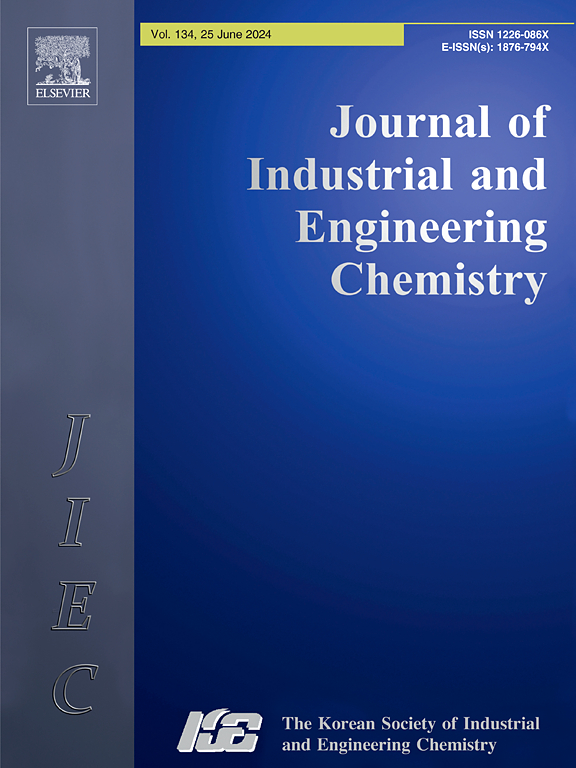Dual-mode fluorescent probe for rapid lead detection in water and gasoline based on a perylene/β-cyclodextrin hybrid sensor
IF 5.9
3区 工程技术
Q1 CHEMISTRY, MULTIDISCIPLINARY
Journal of Industrial and Engineering Chemistry
Pub Date : 2024-11-19
DOI:10.1016/j.jiec.2024.11.036
引用次数: 0
Abstract
Lead is a toxic heavy metal utilized in various industrial applications, presenting considerable environmental and health hazards. Thus, its rapid detection is necessary in various industrial applications to prevent its toxic effecs. This study introduces a novel fluorescent probe utilizing perylene-3,4,9,10-tetracarboxylic diimide (PTCDI) modified with β-cyclodextrin (B_CD) to lead ion detection and mitigate the inherent hydrophobicity of PTCDI. B_CD is initially modified with aldehyde groups (B_CDA) and subsequently linked to PTCDI through the Schiff-base reaction to produce the final PI_CDA probe. The synthesis of PI_CDA is confirmed through Fourier-transform infrared (FTIR) and nuclear magnetic resonance (NMR) spectroscopies. Field emission scanning electron microscopy (FE-SEM) demonstrates distinct self-assembly structures, transitioning from clumped aggregates in B_CD to elongated cylindrical morphologies in PI_CDA, thereby underscoring the influence of chemical modification on nanostructure formation. The probe demonstrates enhanced fluorescence emission through the photoinduced electron transfer (PET) mechanism, facilitating the selective detection of lead ions while avoiding interference from other metal cations. The detection limit of this sensor for lead ions is determined 1.6 μM, with a maximum detection range of 55 μM. Furthermore, PI_CDA exhibits effective lead detection in gasoline, addressing a notable environmental issue.

基于苝/β-环糊精混合传感器的双模荧光探针用于水和汽油中铅的快速检测
铅是一种有毒的重金属,在各种工业应用中使用,对环境和健康造成相当大的危害。因此,它的快速检测是必要的,在各种工业应用,以防止其毒性作用。本研究利用β-环糊精(B_CD)修饰的苝-3,4,9,10-四羧基二亚胺(PTCDI)荧光探针来检测铅离子,并减轻PTCDI固有的疏水性。B_CD最初被醛基修饰(B_CDA),随后通过希夫碱反应与PTCDI连接,生成最终的PI_CDA探针。通过傅里叶变换红外光谱(FTIR)和核磁共振(NMR)证实了PI_CDA的合成。场发射扫描电镜(FE-SEM)显示了不同的自组装结构,从B_CD中的团块聚集体转变为PI_CDA中的细长圆柱形,从而强调了化学修饰对纳米结构形成的影响。该探针通过光致电子转移(PET)机制增强了荧光发射,促进了铅离子的选择性检测,同时避免了其他金属阳离子的干扰。该传感器对铅离子的检测限为1.6 μM,最大检测范围为55 μM。此外,PI_CDA在汽油中表现出有效的铅检测,解决了一个显着的环境问题。
本文章由计算机程序翻译,如有差异,请以英文原文为准。
求助全文
约1分钟内获得全文
求助全文
来源期刊
CiteScore
10.40
自引率
6.60%
发文量
639
审稿时长
29 days
期刊介绍:
Journal of Industrial and Engineering Chemistry is published monthly in English by the Korean Society of Industrial and Engineering Chemistry. JIEC brings together multidisciplinary interests in one journal and is to disseminate information on all aspects of research and development in industrial and engineering chemistry. Contributions in the form of research articles, short communications, notes and reviews are considered for publication. The editors welcome original contributions that have not been and are not to be published elsewhere. Instruction to authors and a manuscript submissions form are printed at the end of each issue. Bulk reprints of individual articles can be ordered. This publication is partially supported by Korea Research Foundation and the Korean Federation of Science and Technology Societies.

 求助内容:
求助内容: 应助结果提醒方式:
应助结果提醒方式:


